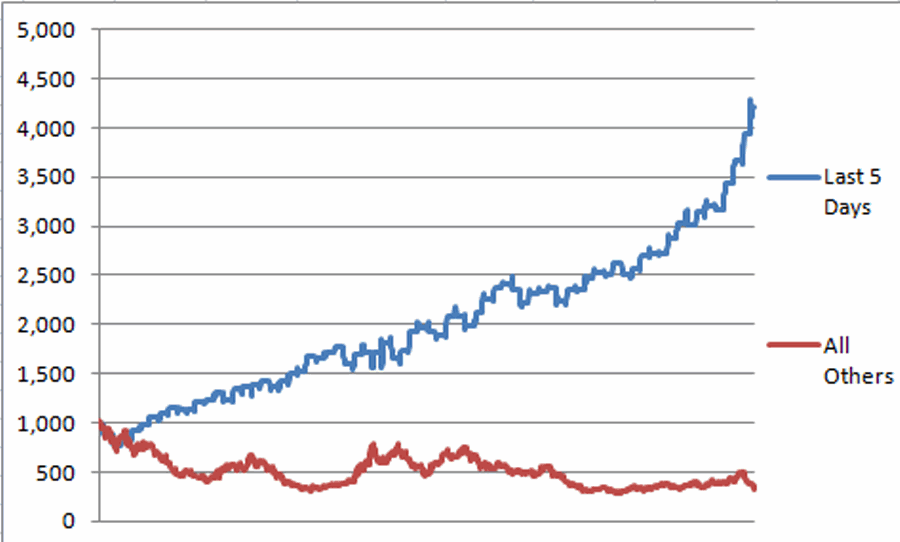Before I detail any sort of “strategy” (and please note that the use of the word “strategy” and the lack of the words “mechanical trading system guaranteed to generate obscene profits ad infinitum into the future”) let me address a few questions that have come up since I wrote this article.
Last week I wrote about the tendency for t-bonds to perform well during the last five trading days of the month – particularly when compared to all other days (which actually show a fairly sizable net loss).
I got a number of questions so rather than going through them one by one, let me put the following “things” out there:
*As always I am not advocating that a trader use this idea as a mechanical “system” (although I am about to do that just for fun), I am just letting you know what I’ve seen.
*One gnawing caveat is that – as a few alert readers pointed out – the bond market has been in a relentless bull market for, oh, about 30 years or so. The next 30 years are unlikely to be quite as good for bonds as the past 30 years. Still, the fact that the overall treasury bond market has been in an overall long-term bullish trend this does not exactly explain the fact that the last five days of the month “made a lot of money” while all the other trading days of the month “lost a lot of money.” In other words, all the other days of the month occurred within the context of the same bull market as the last five days of the month. So how does bonds being in a long-term uptrend explain this difference?
*Several readers asked if there is a reason “why” this tendency has persisted. And I am very tempted to try to offer up with some plausible, logical, intelligent, well thought out, economically viable reason in order to “solidify my bonafides” (which sounds like something that might need medical supervision, but I digress). But as I guy from the South Side I once knew would say, “I got nuttin’”. Sorry folks, I’m just a “numbers geek.” One alert reader posited that it is due to “Month end window dressing bond buying.” Which makes good sense to me. But again, I’m just a numbers guy.
*Several readers asked if there are good days for going short. I may write about this in the future but in a nutshell here is what I have found:
Yes, certain trading days of the month have shown a net loss over the past 30 years. The caveat is that they are sort of random throughout the month. Personally I put more faith in a tendency that persists over five contiguous days (i.e., the bullish trend during the last 5 days of the month) – even if I can’t really explain why it matters – than in one that picks out a day here and a day there. Not exactly scientific but there you have it.
Trading with TMF
Alright thrill seekers, better strap yourself in. (NYSE:TMF) is an ETF that seeks to track the daily performance of the long-term treasury bonds times 3. So if t-bonds go up 1% today then in theory, TMF should gain 3%. You already see where I am going with this don’t you? So if you had a method for identifying bullish periods for treasury bonds you could buy TMF instead of a standard bond fund or ETF and make three times as much money, right?
Well, again, in theory, yes. But how about in practice? Let’s take a look.
Under the category of “It’s Kind of a Short Track Record”, TMF started trading on 4/16/2009. So let’s look at the following:
- How has TMF performed during the last 5 trading days of the month
- How has TMF performed during “all other trading days”
The answer is fairly stark and appears in Figure 1.

Figure 1 – Growth of $1,000 invested in TMF during last 5 days of each month (blue) versus Growth of $1,000 invested in TMF during all other days (red); 4/16/2009 through 3/6/2015
For the record:
- $1,000 invested in TMF during bullish days grew to $4,217 (+322%).
- $1,000 invested in TMF during all other days declined to $329 (-67%)
As I am wont to point out, these types of contrasting performances are what we “quantitative types” typically refer to as “statistically significant.”
To highlight the stark contract in performance consider the annual results displayed in Figure 2 (note: there are no slippage or commission deductions included so real-world number would almost certainly be reduced).

Figure 2 – Annual Results (TMF Last 5 Days of Month versus all other days)
*-starting on 4/16/2009
**-ending on 3/6/2015
Let me make two general statements regarding these results:
1) These number sure are darned exciting!
2) Committing to buy and hold a triple leverage fund for five contiguous day NO MATTER WHAT and to also commit to do so every single month NOT MATTER WHAT is clearly a risky strategy fraught with great peril and should only be considered by people who clearly understand the risks involved.
Summary
So is buying and holding ticker TMF for the last 5 trading days of every single month a viable trading method.? I will leave you to draw your own conclusions. For the record (CYA Alert) I am in no way recommending that you do so. But if you do wish to consider it remember that a strategy such as this belongs squarely in the “High Risk, Do Not Bet the Ranch No Matter How Tempting” category. So please remember:
Jay’s Trading Maxim #313: When considering seasonal trends in the financial markets, always remember that past is prologue. Except when it’s not.
